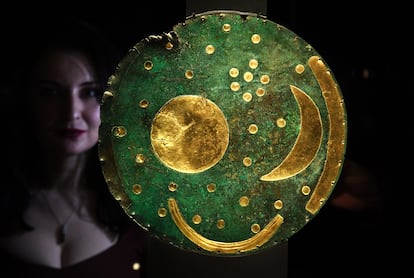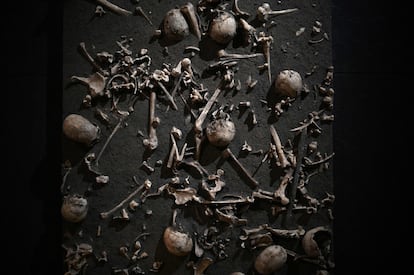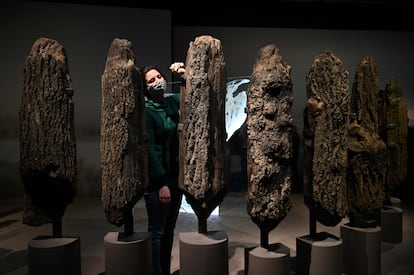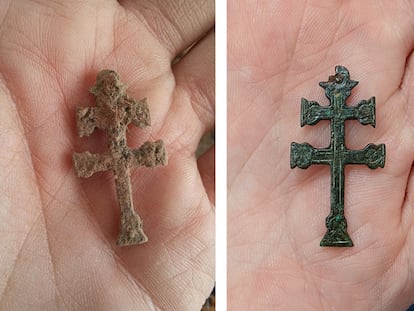The British Museum’s Stonehenge exhibition: An accessible, comprehensive guide (albeit with no druids…)
Treasures such as the Nebra sky disc and Seahenge are there to be discovered at the show, which cleverly links the prehistoric site to our present times

A visit to the major new exhibition at London’s British Museum on Stonehenge, the famous circle of prehistoric stones located in the south of England, ends with a scale photo of a beautiful pastel-colored sunset between the iconic lintels, a small object made of gold that appears to represent a partial solar eclipse, and a phrase about the monument uttered in 1967 by archeologist, writer and anti-nuclear campaigner Jacquetta Hawkes (1910-1996): “Every age has the Stonehenge it deserves – or desires.”
The exhibition, which opened this week and will run until July 17, boasts 430 objects (two-thirds of which have been lent by a total of 35 institutions), among them treasures such as the Nebra sky disc, believed to be the oldest depiction of the cosmos, as well as Seahenge, a stunning prehistoric wood circle that was located in the English county of Norfolk.
The organizers appear to have stipulated just which is our Stonehenge, and just how we should interpret this mysterious monument. In many ways, it is a Stonehenge of our times: from the choice of Hawkes to mark the end of the visit, and the efforts not to ignore the role of women in the exhibition’s narrative, to the emphasis on environmental issues, as well as the denunciation of violence and war. There is also an unexpected mention of “gender-neutral” individuals, related to a funeral dowry in which traditionally male and female objects are mixed.
The World of Stonehenge, as the exhibition is titled, takes advantage of two recent archeological endeavors: the Stonehenge Riverside Project and the Hidden Landscape Project. It is also based on the opposition between the construction of communal monuments such as the famous stone circle, and the later appearance of portable, individual objects that began to gain spiritual and social importance. There is an extraordinary selection of mostly gold objects that represent the sun.
As the museum’s director has joked, they would have had a tough time bringing the stone circle itself to London. But there is, at least, a piece of the monument: a fragment of one of the famous “blue stones” that was donated by celebrated war poet Siegfried Sassoon.
That said, one of the most surprising elements of the exhibition is the complete absence of the druids – not a single mention is to be found. It is true that the scientists who study Stonehenge are sick to death of the druids, who have been popularly and mistakenly associated with the monument since antiquarians such as William Stukely began to study it back in the 18th century. But it is no less true that, at an exhibition about Stonehenge, the druids should appear, whether we like it or not, if only to explain that they have nothing to do with the site.
Questioned about the omission by EL PAÍS, curator Neil Wilkin responded by saying that “Stonehenge is not their era,” and that to include them “the exhibition would have to be greatly expanded.” He did, however, concede that the elimination of the druids from the exhibition is “significant.”
Whatever the case, the litmus test for an exhibition about Stonehenge is whether or not it manages to achieve the difficult task of explaining a monument as complex as this one to the wider public. And it must be said that the visitor does indeed come out with a fairly precise idea of what Stonehenge is, and why it is important – and that is despite the fact that the journey spans 9,000 years, and three different periods: Mesolithic, Neolithic and Bronze Age. The 1,500 most-intense years of activity at Stonehenge, from 5,000 to 3,500 years ago, are equivalent to 100 human generations. It’s enough to make anyone’s head spin…

The exhibition argues that Stonehenge is aligned with the rising and setting of the sun at the solstices, moments when it was thought that the community’s fate was hanging in the balance. But it makes clear that the monument was not an observatory of the skies, a calendar or a place to predict eclipses or other celestial phenomena in a scientific or mathematical way, but rather that the alignments were important for the gatherings and religious rites that were celebrated on the site.
Many parts of the exhibition appeal to the emotions via a carefully crafted and striking staging, which includes cycloramas with dawns, sunsets and the night sky. The “eternal mystery of Stonehenge” can only be understood, it stresses, “exploring the world around that made it possible.”
The objects from the exhibition, the introduction explains, track fundamental changes in the “relationship of people with the sky, the Earth and some individuals with others.” The importance of the sun as a source of light and fertility, and the connection that the monoliths establish between the sky and the Earth are some of the concepts that are dealt with at the start, as well as the transition 6,000 years ago from the world of hunter-gatherers, to that of agriculture. The exhibition constantly shows parallels with other constructions.
Seahenge
One of the star attractions of the exhibition is the aforementioned Seahenge, a timber circle dating from 4,000 years ago and made up of 55 oak trunks. Discovered on the coast of Norfolk in 1998 and preserved under a layer of sand, it was aligned with the sunrise during the summer solstice. The exhibition of the monument is accompanied by an evocative sound installation, with noises of wind, waves and insects.

Those who are familiar with the history of the monument will recognize the sub-themes of the exhibition, such as the allusion to the supposed contact with Mycenae, the mystery of the Stonehenge Archer (was he sacrificed, or a victim of combat?) whose remains were found in the outer ditch, the dagger graffiti and the funeral mounds.
A small epilog – featuring drawings by William Blake, wherein he reimagines the monument – includes the indisputable assertion that “Stonehenge remains,” and that by doing so, it represents the memory of a people who, generation after generation, “gave meaning from a lasting place to a changing world.”
Tu suscripción se está usando en otro dispositivo
¿Quieres añadir otro usuario a tu suscripción?
Si continúas leyendo en este dispositivo, no se podrá leer en el otro.
FlechaTu suscripción se está usando en otro dispositivo y solo puedes acceder a EL PAÍS desde un dispositivo a la vez.
Si quieres compartir tu cuenta, cambia tu suscripción a la modalidad Premium, así podrás añadir otro usuario. Cada uno accederá con su propia cuenta de email, lo que os permitirá personalizar vuestra experiencia en EL PAÍS.
¿Tienes una suscripción de empresa? Accede aquí para contratar más cuentas.
En el caso de no saber quién está usando tu cuenta, te recomendamos cambiar tu contraseña aquí.
Si decides continuar compartiendo tu cuenta, este mensaje se mostrará en tu dispositivo y en el de la otra persona que está usando tu cuenta de forma indefinida, afectando a tu experiencia de lectura. Puedes consultar aquí los términos y condiciones de la suscripción digital.
More information
Últimas noticias
The new victims of the Republican war on Obamacare: Millions hit by soaring health insurance premiums
A country divided on migrant rights: Some US states expand protections while others restrict them
Venezuela authorizes the release of another 87 political prisoners
There is as much life left to discover on planet Earth as that which is already known
Most viewed
- David King, chemist: ‘There are scientists studying how to cool the planet; nobody should stop these experiments from happening’
- Reinhard Genzel, Nobel laureate in physics: ‘One-minute videos will never give you the truth’
- Oona Chaplin: ‘I told James Cameron that I was living in a treehouse and starting a permaculture project with a friend’
- Sinaloa Cartel war is taking its toll on Los Chapitos
- The Interoceanic Train, the Mexican alternative to the Panama Canal











































